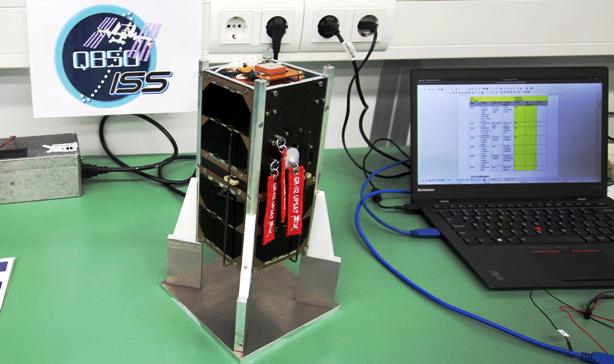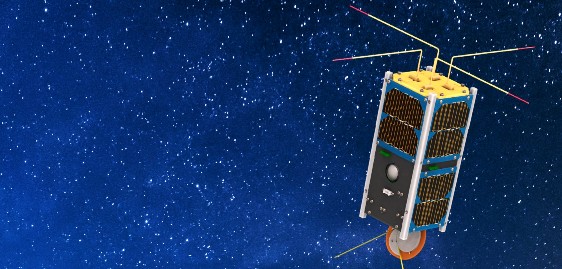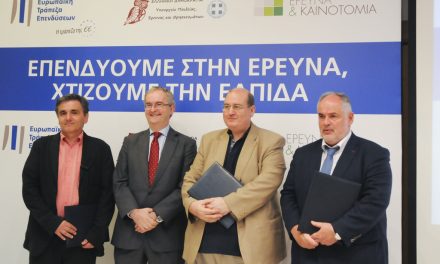Greek space industry is getting prepared for the launch, to be scheduled during late March-early April 2017, of the first nano-satellite built in Greece (UPSat) which at the same time is the first ever open source hardware and software satellite.
Engineers from the University of Patras and Libre Space Foundation (the makers of UPSat), in cooperation with Von Karman Institute and Netherlands based Innovative Solutions In Space engineers, have successfully concluded all needed tests and checkout procedures to enable UPSat’s integration to the NanoRacks launch system. Subsequently, UPSat will be delivered to Orbital ATK, and then launched to the International Space Station (ISS) via a Cygnus automated cargo spacecraft. After successful docking to ISS, UPSat will be launched by the NanoRacks deployment pod aboard ISS.
Why nano-satellite? Because it is based on nanotechnology and its dimensions are 20cm -10cm -10 cm (see photo below)! The satellite was delivered almost a year ago completing a major step towards UPSat’s launch. Its delivery marked a major milestone towards the realization of Libre Space Foundation vision for an open source technologies ecosystem in space, while also being the first satellite built in Greece. UPSat is the first complete delivery to ISISpace as part of the QB50 project. What is the QB50 mission? The QB50 mission will demonstrate the possibility of launching a network of 50 CubeSats built by Universities Teams all over the world, as a primary payload on a low-cost launch vehicle to perform first-class science in the largely unexplored lower thermosphere. Space agencies are not pursuing a multi-spacecraft network for in-situ measurements in the lower thermosphere, because the cost of a network of 50 satellites built to industrial standards would be extremely high and not justifiable in view of the limited orbital lifetime. No atmospheric network mission for in-situ measurements has been carried out in the past or is planned for the future. A network of satellites for in-situ measurements in the lower thermosphere can only be realised by using very low-cost satellites, and CubeSats are the only realistic option.

Greece: a leading manufacturer of technology used in European satellites
Greece became a full member of the European Space Agency in 2005. As a member of the European Space Agency, Greece is fully aligned with the European Space Policy and participates in several space programmes and research undertakings.
It’s worth mentioning that only recently (December 2016) and after eight years of “absence” due to fiscal restraints, Greece participated again to the optional European Space Agency’s Programmes by raising 8,2 million euro. ESA waived this decision, which was made possible after the successful effort of the Ministry of Education to secure funding for a three-year investment on optional European Space Agency’s Programmes. Optional programmes cover areas such as Earth observation, telecommunications, satellite navigation and space transportation. Similarly, the International Space Station and microgravity research are financed by optional contributions.
In an interview to the daily Kathimerini, Athanassios Potsis, president of the Hellenic Association of Space Industry (HASI) mentioned: “40 Greek companies currently deal with space” “Their turnover exceeds €200 million annually; they employ about 5,000 people and export 99.9% of their products.”
One of them is European Sensor Systems (ESS) creating innovative products used for space applications, such as sensors which are used to monitor the amount of fuel in a satellite’s tank. The European Sensor Systems (ESS) employthe technology of Microelectromechanical Systems (MEMS) and is the only company producing them. In 2007 they signed their first contract with the European Space Agency (ESA). ESA were very pleased and recommended them to Airbus, one of the two European giants, along with Thales, operating space missions. Today they are major suppliers of satellite pressure sensors and accelerators.
It’s not just the ESS. Another Greek company, TELETEL S.A produces hardware which controls the smooth functioning of key subsystems of satellites prior to launch and software that controls their flight mode. Hellas SAT provides information data transmission and voice services to a large number of users around the world. Prisma Electronics manufactures special cables for space while INASCO makes devices with composite materials used in space because of their light weight andstrength.
Greece is a leading manufacturer of technology used in European satellites. A new-born and fast-growing Greek cluster of enterprises investing in space-related technologies (Hellenic Space Technologies and Applications Cluster), si-Cluster has been running since 2012 in the context of Corallia Clusters Initiative, a larger cutting edge tech cluster based in Athens and Patras.
“Our industry is built from scratch, with companies focused on innovation. When preparing a mission to Mars, for example, they want a reliable product that won’t let them down.” Over time, their customer base widened. China, Israel, Canada and India have expressed interest in Greek space products. The challenge they now face is brain drain during Greece’s crisis. “We have a lot of excellent scientists, who go overseas, make a new product there, which Greece will then be obliged to buy because we need it. Isn’t it absurd?” says Potsis.

Read more from – Greek News Agenda: Innovation Clusters: Greece-France Cooperation Reaches Space ; Interview with Costas Fotakis, Minister for Research and Innovation; General Secretariat for Research & Technology: Greece – Space Capabilities Catalogue; UN Space Generation Advisory Council: Overview of Greek Space Sector; National Observatory of Athens: Institute for Astronomy, Astrophysics, Space Applications and Remote Sensing; AMNA: Greek satellite launched from NASA Flight Facility in Virginia














